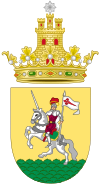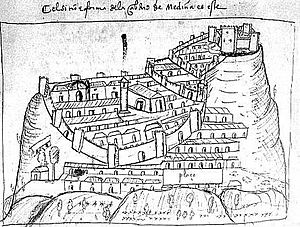Medina-Sidonia facts for kids
Quick facts for kids
Medina Sidonia
|
|||
|---|---|---|---|
 |
|||
|
|||
| Country | Spain | ||
| Autonomous community | Andalusia | ||
| Province | Cádiz | ||
| Area | |||
| • Total | 493 km2 (190 sq mi) | ||
| Elevation | 337 m (1,106 ft) | ||
| Population
(2018)
|
|||
| • Total | 11,658 | ||
| • Density | 23.647/km2 (61.25/sq mi) | ||
| Time zone | UTC+1 (CET) | ||
| • Summer (DST) | UTC+2 (CEST) | ||
| Website | http://www.medinasidonia.com/ | ||
Medina Sidonia is a historic city and municipality located in the province of Cádiz in southern Spain. It is part of the region of Andalusia. Some people believe it is one of the oldest cities in Europe. Its high location makes it a great spot for military defense. People from Medina Sidonia are called Asidonenses. The city's name comes from "Medina," which means "City" in Arabic, and "Sidonia," which refers to Sidon. So, its name means "City of Sidon."
Medina Sidonia was once a very important place for dukes in Spain during the 15th century. A famous admiral from here, Alonso Pérez de Guzmán, 7th Duke of Medina Sidonia, led the Spanish Armada in a big naval battle against England in 1588. The title of Duque de Medina Sidonia was given to the family of Guzmán El Bueno because of his brave actions in taking the town. This family line continued, and the Duchess until 2008 was Luisa Isabel Álvarez de Toledo, 21st Duchess of Medina Sidonia.
A Look at Medina Sidonia's Past
This city was likely an ancient settlement called Asido. It was an Iberian town that might have been started by the Phoenicians. This is why it was later called Sidonia, connecting it to the city of Sidon. We know about its early days from old coins. Coins from the 2nd and 1st centuries BC have the Latin word Asido on them. They also show Punic writings like sdn or b'b'l. You can often see pictures of Herakles and dolphins on these coins.
Medina Sidonia is about 30 kilometers (19 miles) inland from the southern Spanish coast. It sits on a hill about 35 kilometers (22 miles) east of modern Cadiz.
By the 3rd century BC, the Romans had taken control of much of southern Spain. When the Romans ruled, this place was known as Asido Caesarina.
In 571, the Visigothic king Liuvigild attacked the Byzantines and captured Medina Sidonia. Then, in 712, the town was conquered by the Muslim leader Musa ibn Nusayr. It became the main city of the Sidonia province in the emirate of Spain.
Medina Sidonia returned to Christian control in 1264, thanks to Alfonso X of Castile. It became an important fort along the border with the last Muslim kingdom in the Iberian Peninsula, the Kingdom of Granada. It was also home to several military orders, which were groups of knights.
In 1440, the city became part of the lands owned by the Dukes of Medina-Sidonia.
What to See in Medina Sidonia
The town is known for its old medieval walls and its neat, narrow streets made of cobblestones. Many houses have beautiful reja (iron grilles) on their windows.
Some interesting places to visit include:
- The Castle (built between the 13th and 15th centuries)
- Roman archaeological complex (from the 1st century AD)
- Town Hall (built in the 16th century)
- La Alameda (a historic area from the 16th century)
- Ducal Stables (built in the 16th century)
- Church of Saint Mary the Crowned (known as Iglesia de Santa María la Coronada)
- Castle of Torre-estrella (from the 13th century)
Images for kids
-
Official portrait of Agrippina the Elder (14 BC–33 AD), found in Medina-Sidonia
See also
 In Spanish: Medina Sidonia para niños
In Spanish: Medina Sidonia para niños


















